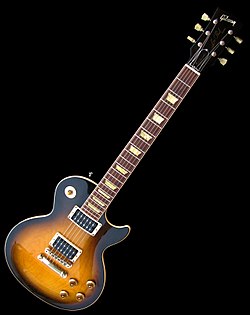 Gibson Les Paul
Gibson Les Paul
| Gibson Les Paul | |||||||||||||
|---|---|---|---|---|---|---|---|---|---|---|---|---|---|
| Manufacturer | Gibson, Epiphone | ||||||||||||
| Period | 1952–1960, 1968–present | ||||||||||||
| Construction | |||||||||||||
| Body type | Solid | ||||||||||||
| Neck joint | Set-in | ||||||||||||
| Woods | |||||||||||||
| Body | Mahogany (often with a maple top), swamp ash | ||||||||||||
| Neck | Mahogany, maple | ||||||||||||
| Fretboard | Rosewood, ebony, maple (usually 22 frets) | ||||||||||||
| Hardware | |||||||||||||
| Bridge | Usually hardtail (Tune-O-Matic) | ||||||||||||
| Pickup(s) | Usually H-H (2 Humbucker) | ||||||||||||
| Colors available | |||||||||||||
Origins and history
In 1951, this initial rejection became a design collaboration between the Gibson Guitar Corporation and Les Paul. It was agreed that the new Les Paul guitar was to be an expensive, well-made instrument in Gibson's tradition. Although recollections differ regarding who contributed what to the Les Paul design, it was far from a market replica of Fender models. Founded in 1902, Gibson began offering electric hollow-body guitars in the 1930s, such as the ES-150; at minimum, these hollow-body electric models provided a set of basic design cues for the new Gibson solid-body, including a more traditionally curved body shape than offered by competitor Fender, and a glued-in ("set-in") neck, in contrast to Fender's bolt-on neck
The significance of Les Paul's contributions to his Gibson guitar design remains controversial. The book "50 Years of the Gibson Les Paul" limits Paul's contributions to two: advice on the trapeze tailpiece, and a preference for color (stating that Paul preferred gold as "it looks expensive", and a second choice of black because "it makes your fingers appear to move faster on the box", and "looks classy―like a tuxedo").
Additionally, Gibson's president Ted McCarty states that the Gibson Guitar Corporation merely approached Les Paul for the right to imprint the musician's name on the headstock to increase model sales, and that in 1951, Gibson showed Paul a nearly finished instrument. McCarty also claims that design discussions with Les Paul were limited to the tailpiece and the fitting of a maple cap over the mahogany body for increased density and sustain, which Les Paul had requested reversed. However, according to Gibson Guitar, this reversal would have caused the guitar to become too heavy, and Paul's request was refused. Another switch: the original Custom was to be all mahogany and the Goldtp was to have the maple cap/mahogany body. Beyond these requests, Les Paul's contributions to the guitar line bearing his name were stated to be cosmetic. For example, ever the showman, Paul had specified that the guitar be offered in a gold finish, not only for flashiness, but to emphasize the high quality of the Les Paul instrument, as well. The later-issue Les Paul models included flame maple (tiger stripe) and "quilted" maple finishes, again in contrast to the competing Fender line's range of car-like color finishes. Gibson was notably inconsistent with its wood choices, and some goldtops have had their finish stripped to reveal beautifully figured wood hidden underneath.


Geen opmerkings nie:
Plaas 'n opmerking